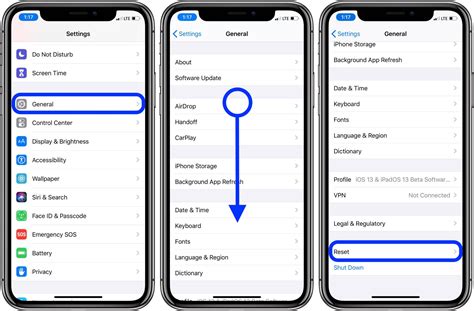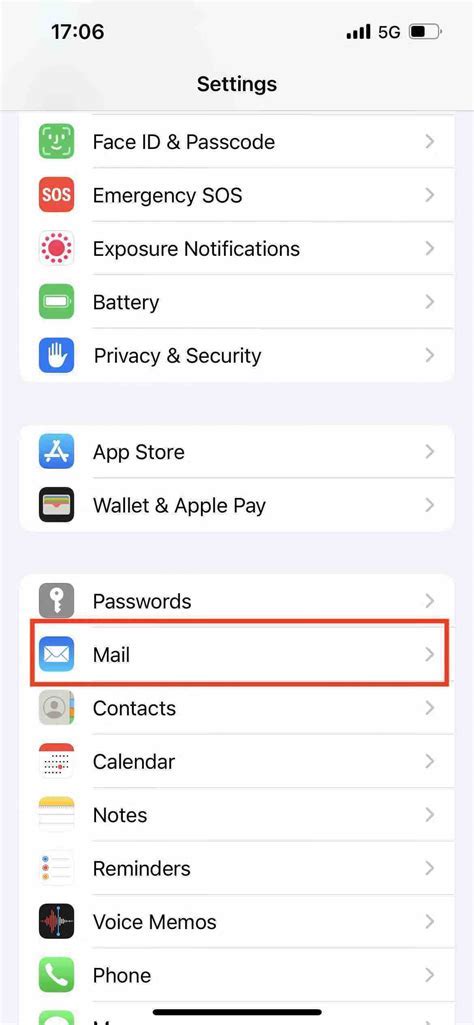In today's digital era, smartphones hold a significant place in our lives, functioning as not just phones, but also as personal assistants, cameras, and even wallets. With such extensive usage, it becomes essential to ensure that our valuable data, including contact information, remains intact even when undertaking essential tasks, such as resetting our iPhones to factory settings.
When erasing all content and settings on your iPhone, it is crucial to have a strategy in place to safeguard your valuable contact numbers. Losing this information could mean losing touch with friends, family, colleagues, clients, or potential job opportunities. That's where we come in, providing you with expert advice on how to efficiently manage and preserve your phonebook during the Apple iPhone factory reset process.
Our comprehensive guide will demonstrate various methods and precautions to protect and recover your contact information, ensuring a seamless transition even after resetting your iPhone. We'll explore strategies such as utilizing cloud-based services, leveraging third-party applications, and utilizing backup options within the iPhone system itself.
Additionally, we'll delve into the potential pitfalls and challenges that you may encounter during the factory reset process and how to address them effectively. It is crucial to stay informed about the nuances of resetting your iPhone to mitigate any potential data loss or inconvenience that may arise as a result.
Preserving Your Contacts on iPhone before Restoring to Default Settings

When going through the process of restoring your iPhone to its factory settings, it is crucial to take necessary precautions to ensure that your valuable contacts are not lost forever. By following a few simple steps, you can successfully safeguard your contacts and have them readily available after the reset.
- Start by accessing the Contacts application on your iPhone. This app contains all the contact information you have stored over time.
- Next, explore the available options for exporting or backing up your contacts. This step is essential to prevent any loss during the restoration process.
- You can choose to sync your contacts with a cloud-based service such as iCloud. By doing so, your contacts will be stored securely and can be easily retrieved later.
- Alternatively, you can consider exporting your contacts to your computer or another external storage device. This method provides an additional layer of protection, ensuring that you have a physical copy of your contacts.
- Remember to double-check the export or backup file to confirm that all your contacts have been successfully saved. Taking this extra step will give you peace of mind before proceeding with the reset.
By proactively preserving your contacts before restoring your iPhone to its factory settings, you eliminate the risk of losing crucial contact information. Following these steps will allow you to seamlessly restore your iPhone while ensuring that your valuable contacts remain intact and easily accessible.
Why it is Vital to Preserve Contact Information before Restoring Your iPhone
In today's digital age, our smartphones have become an essential tool for communication and storing important information. A significant part of this information is our contact list, which contains the phone numbers, email addresses, and other details of our family, friends, colleagues, and acquaintances. Before undertaking any major changes to our iPhones, such as resetting them to factory settings, it is crucial to preserve this valuable contact information.
By saving your contacts before resetting your iPhone, you ensure that you don't lose touch with the people who matter most to you. Losing your contact list can cause inconvenience, missed opportunities, and even strained relationships. Therefore, taking the time to safeguard your contacts serves as a preventive measure against these potential challenges.
Moreover, resetting your iPhone to its factory settings is often done to resolve software issues, improve performance, or prepare the device for resale. However, this action will wipe out all your data and settings, including your contacts, if they were not backed up beforehand. Without a backup, you would need to manually re-enter each contact, which can be a time-consuming and error-prone task.
- Data Loss Prevention: Preserving your contact information eliminates the risk of losing vital data.
- Seamless Transition: Backing up your contacts allows for effortless restoration after the reset.
- Time and Effort Savings: Avoid the inconvenience of manually re-entering each contact by maintaining a backup.
- Maintaining Relationships: Keeping your contact list intact helps you stay connected and fosters meaningful connections with others.
In conclusion, saving your contacts before resetting your iPhone is an essential step to protect your valuable information, ensure a smooth transition, save time and effort, and maintain important relationships. Prioritizing the preservation of contact information will safeguard against potential data loss and allow you to remain connected with ease.
Methods for Preserving Contacts on iOS Devices

In the process of restoring an iPhone to its original factory settings, it is crucial to ensure the preservation and transfer of all essential contact information. This section will explore a variety of methods available for safeguarding and retaining your valuable contacts on iOS devices.
iCloud Backup: One of the most convenient ways to save your contacts is by utilizing the iCloud backup feature. By enabling iCloud and backing up your device, you can easily restore your contacts to the same device or a new iPhone.
iTunes Backup: Another reliable option for preserving your contacts is through an iTunes backup. By connecting your device to a computer and creating a backup using iTunes, you can later restore your contacts along with other data.
Email Sync: Syncing your contacts with an email service, such as Gmail or Outlook, is an effective method for ensuring their safety. By enabling contact sync on your iPhone, any changes or additions made to your contacts will be automatically updated across all your devices.
Third-Party Apps: Numerous third-party apps are available on the App Store that offer advanced contact backup and sync features. These apps provide additional functionalities, such as merging duplicate contacts or exporting contacts in various formats for easy migration to other devices.
Exporting as vCard: If you prefer a more traditional approach, you can export your contact list as a vCard file. This file can then be imported into other devices or email services, ensuring your contacts are safely preserved.
By using any of these methods, you can effectively safeguard your contacts and effortlessly restore them to your iPhone after resetting it to factory settings. Choose the method that best suits your needs and preferences to retain all valuable contact information.
Tips to Ensure a Smooth Transfer of Contacts after Restoring Your iPhone
When resetting your iPhone to its factory settings, it is important to take certain precautions to ensure that your contacts are not lost in the process. In this section, we will discuss some helpful tips to help you smoothly transfer your contacts back to your iPhone after the reset.
1. Backup your contacts: To avoid any potential data loss, it is recommended to create a backup of your contacts before resetting your iPhone. This can be done by syncing your contacts with iCloud or using third-party backup solutions.
2. Export contacts to a vCard file: Another way to safeguard your contacts is by exporting them to a vCard file. This file can then be easily imported back to your iPhone after the reset, ensuring that your contacts are preserved.
3. Sync contacts with a cloud service: Many cloud services, such as Google Contacts or Microsoft Outlook, offer seamless synchronization of contacts across devices. By syncing your contacts with a cloud service, you can easily restore them to your iPhone after the reset.
4. Utilize a third-party contact management app: There are various contact management apps available that offer advanced features for managing and transferring contacts. These apps can help you streamline the transfer process and ensure that your contacts are securely stored and restored.
5. Check iCloud settings: If you use iCloud to store your contacts, double-check your iCloud settings after the reset to ensure that the contacts are set to sync with your iPhone. This will ensure that your contacts are automatically restored when you sign in to your iCloud account on your reset device.
By following these tips, you can minimize the risk of losing your contacts while resetting your iPhone to its factory settings. Keeping your contacts safe and ensuring a smooth transfer will ensure that you have all your important numbers at your fingertips, even after a reset.
How to Recover Contacts on iPhone – No Backup | iPhone Contacts Missing & Disappeared
How to Recover Contacts on iPhone – No Backup | iPhone Contacts Missing & Disappeared by Appgeeker 97,152 views 2 years ago 5 minutes, 29 seconds
How To Correctly Reset iPhone To Factory Default (eSIM too)
How To Correctly Reset iPhone To Factory Default (eSIM too) by zollotech 48,679 views 9 months ago 7 minutes, 44 seconds
FAQ
Can I save my phone numbers when resetting my iPhone to factory settings?
Yes, you can save your phone numbers when resetting your iPhone to factory settings by backing up your device before performing the reset. This will allow you to restore your contacts after the reset is complete.
What is the best way to back up my iPhone contacts before resetting to factory settings?
The best way to back up your iPhone contacts before resetting to factory settings is by using iCloud or iTunes. iCloud allows you to automatically backup your entire device, including contacts, to the cloud. iTunes, on the other hand, allows you to create a manual backup of your iPhone on your computer.
Will I lose all my phone numbers if I reset my iPhone to factory settings without backing up first?
Yes, if you reset your iPhone to factory settings without backing up first, you will lose all your phone numbers along with any other data on your device. It is important to always backup your iPhone before performing a factory reset to avoid permanent data loss.
Can I save my phone numbers to my SIM card before resetting my iPhone to factory settings?
No, iPhones do not have the capability to save contacts directly to the SIM card. The SIM card on an iPhone is primarily used for cellular network authentication and does not provide storage for contacts. You will need to use alternative methods such as iCloud or iTunes to backup your contacts before resetting the iPhone.
Is it possible to retrieve lost phone numbers after a factory reset on an iPhone?
Unfortunately, retrieving lost phone numbers after a factory reset on an iPhone is not possible if you did not make a backup of your device prior to the reset. Factory reset erases all data on the iPhone, making it difficult or impossible to recover lost contacts.
What happens to my phone numbers when I reset my iPhone to factory settings?
When you reset your iPhone to factory settings, all the data, including phone numbers, will be erased from your device.




